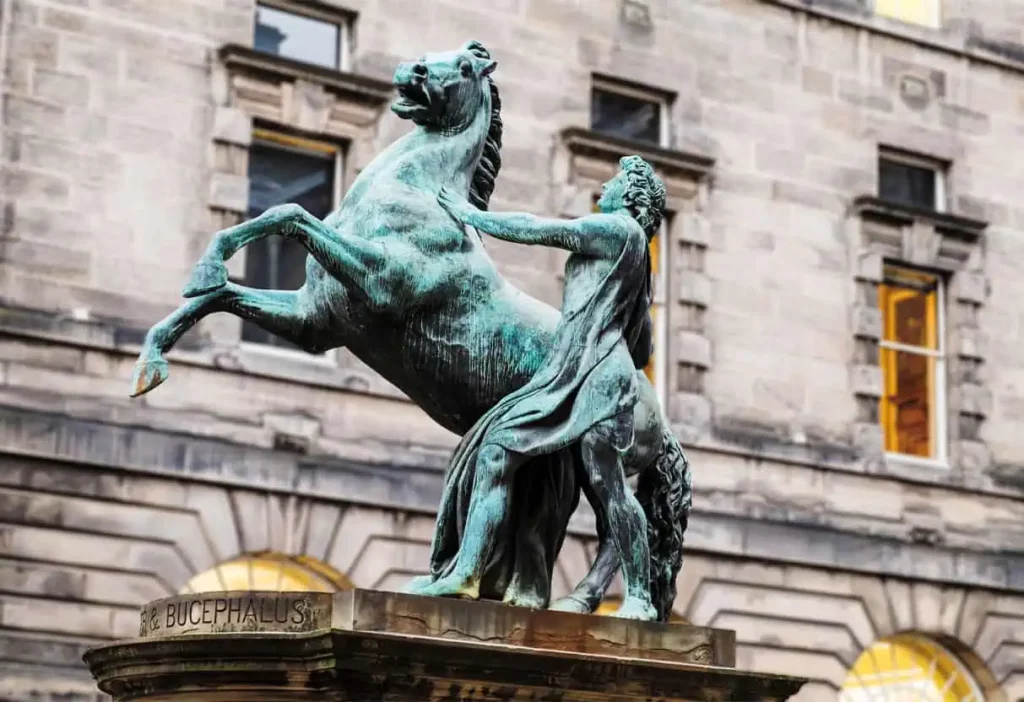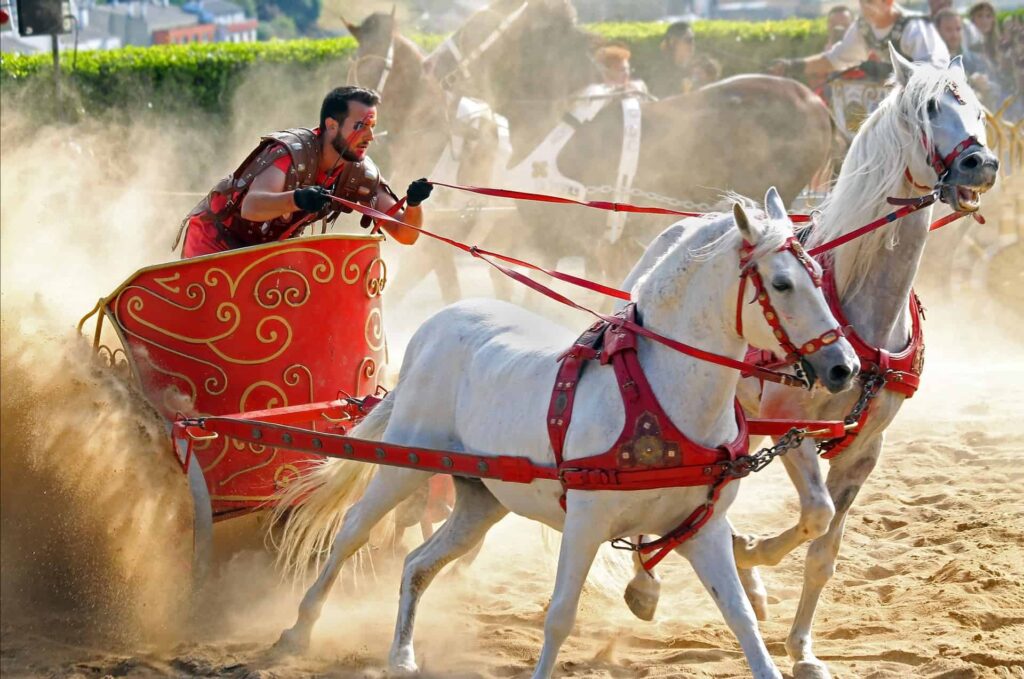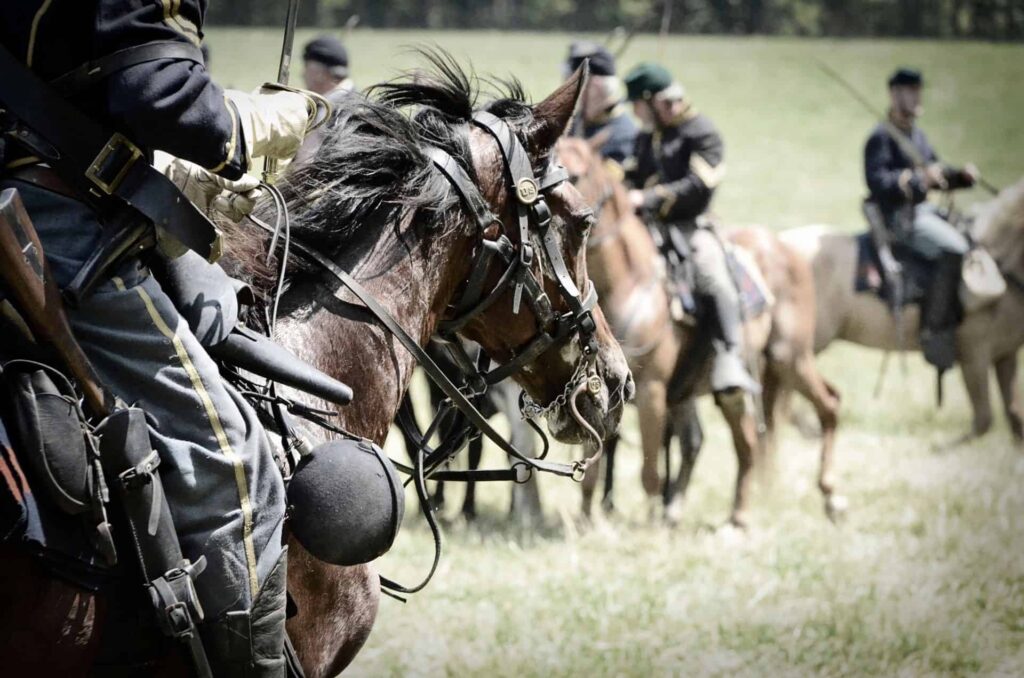Bucephalus stands as a legendary figure, not only in the annals of equine history but also within the larger tapestry of the ancient world. This famous war horse is most renowned for his association with Alexander the Great, one of history’s most storied military leaders. The story of Bucephalus’s taming, which highlights Alexander’s bravery and astuteness even as a young man, transcends mere animal mastery to symbolize a remarkable human-animal bond that has captivated imaginations for centuries.
While Bucephalus’s exact origins are shrouded in the mists of history, his influence as Alexander the Great’s trusted steed is well documented. The two figures are often mentioned in tandem, illustrating their inseparable bond as they embarked on numerous military campaigns that expanded the Macedonian Empire. The horse’s imposing presence and formidable nature in battle alongside Alexander underscored his role as more than a mere transport; he was a symbol of military prowess and kingly authority. Bucephalus’s death, purportedly from battle wounds, marked not just the loss of a beloved companion, but the end of an era, inspiring numerous artistic and cultural homages.
Key Takeaways
- Bucephalus is emblematic of the deep connections formed between historical figures and their steeds.
- The horse played a significant role in Alexander the Great’s military conquests and personal life.
- Bucephalus’s enduring legacy is reflected in the arts and the continued fascination with his story.
Historical Background
Bucephalus stands not only as one of the most celebrated horses in ancient history but also as a symbol of the might and influence of Macedonia under the reign of Philip II and his son, Alexander the Great.
Bucephalus Origin and Discovery
Bucephalus, believed to be of the Thessalian strain, was more than just an exceptional horse; he was a symbol of unmatched strength and trust. Discovered in Macedonia, a region renowned for skilled horse breeding, Bucephalus quickly distinguished himself.
Significance in Macedonia
For Macedonia, a kingdom where cavalry played a pivotal role, a horse like Bucephalus was a coveted asset. Macedonian strength on the battlefield, to a great degree, depended on its cavalry’s ability to outmaneuver the opposition. Philip II of Macedon, well-known for his military reforms, would have placed great value on Bucephalus’s abilities.
Connection with Alexander the Great
The bond between Alexander the Great and Bucephalus is one legendary tale of camaraderie and trust. Alexander’s ability to tame Bucephalus when no one else could serve as a testament to his character and destiny. The horse carried Alexander through numerous battles, cementing both their places in the annals of history.
Legend of Taming Bucephalus
The legend of Bucephalus’ taming is marked by young Alexander’s unparalleled determination and insight. The unmanageable steed, presented to Philip by Philoneicus of Thessaly, set the stage for a test of character and horsemanship.
The Challenge
Bucephalus was an extraordinary horse, known for his wild temperament that left him deemed unmanageable by many. Presented by Philoneicus of Thessaly, the horse was brought to the court of King Philip of Macedonia, where it was met with a mixture of awe and trepidation.
Philip’s Bet
King Philip initially saw Bucephalus as beyond control, a challenge no man could conquer. Yet it was his son, Alexander the Great, brimming with the determination unique to future conquerors, who perceived something in Bucephalus that no one else did.
Alexander’s Approach
Alexander’s approach to taming Bucephalus was astute and unconventional. He turned Bucephalus towards the sun, realizing the horse was frightened by his own shadow, and spoke to the horse reassuringly. This act of perception and gentle confidence showcased Alexander’s empathy and expertise, elements crucial to the famed taming event that would forever bond rider and steed.

Role in Military Campaigns
Bucephalus, the famed steed of Alexander the Great, stands as a quintessential figure in the annals of military history, having been a key participant in Alexander’s quest to conquer vast territories of Asia. This section explores the steadfast role of Bucephalus through the significant military engagements that defined the extent of the Macedonian Empire.
Accompanying Alexander
Bucephalus earned a reputation as an exceptional warhorse, having been by Alexander’s side since his youth. Historically documented to have carried Alexander through many military campaigns, his reliability and strength were legendary. Bucephalus and Alexander shared a bond that transcended the typical relationship between a warrior and his mount; it was one of mutual trust and respect, setting a paradigm for cavalry units across various cultures.
Notable Battles
Among the numerous engagements where Bucephalus distinguished himself was the Battle of the Hydaspes in 326 BCE. The formidable battle took place in what is now the Punjab Province of India. Here, Bucephalus’s prowess was on full display as he navigated through the chaos and carnage of the battlefield, contributing significantly to the Macedonian victory against King Porus of the Paurava kingdom.
The Companion of Conquest
The term “companion of conquest” aptly describes Bucephalus during the series of military expeditions led by Alexander the Great across Asia. Bucephalus not only served in battles but also as a symbol of Alexander’s military might and personal leadership. The black steed’s role stretched beyond mere transportation and into the realm of iconographic representation—the embodiment of victory and the spirit of the Macedonian cavalry.
His contribution to Alexander’s legacy of conquest was immortalized by the founding of Bucephala, a city named in his honor at the place of his death, which is believed to have occurred due to battle wounds and exhaustion after the skirmishes in India.
Cultural and Artistic Representations
Bucephalus has cemented its legacy within the realm of cultural and artistic expressions, inspiring literary works and artistic creations. This section explores how Bucephalus has been portrayed through literature and art, reflecting the influence of Greek culture in these mediums.
Bucephalus in Literature
Greek Texts: Bucephalus appears most prominently within the tapestry of Greek literature, where the Alexander Romance serves as a pivotal source. This anthology of mythical and semi-historical accounts of Alexander the Great’s life details his profound connection with his horse, Bucephalus, symbolizing his extraordinary leadership and valor.
Literary Symbolism: Through the narratives, Bucephalus is often a metaphor for Alexander’s own ambitions, representing not only his prowess in battle but also the merging of cultures under his reign. At times, authors contrast the wild spirit of Bucephalus with the calculated discipline of Alexander, illustrating the harmony between nature and intellect.
Depictions in Art
The Alexander Mosaic: One of the most distinguished depictions of Bucephalus is found in the Alexander Mosaic from Pompeii, a stunning example of ancient Roman floor mosaics. This piece is thought to show a battle scene between Alexander and Darius III, capturing the dynamic and powerful form of Bucephalus amidst the chaos of combat.
Greek Artistic Influence: The legacy of Bucephalus and Alexander the Great heavily influenced Hellenistic art. Sculptors and painters of the era often sought to capture the majestic profile of Bucephalus, highlighting the horse’s muscular physique and keen expression. Not mere representations, these works demonstrate the Greek sophistication in capturing motion and emotion, rendering Bucephalus as more than Alexander’s mount, but as a character of historic significance.
Bucephalus’s Death and Legacy
Bucephalus met his end following the Battle of the Hydaspes, leaving a notable legacy that included the founding of a city in his honor.
Final Battle
Bucephalus bravely carried Alexander during the fierce Battle of Hydaspes in what is now modern-day Pakistan, near the Jhelum River. Esteemed for his agility and strength, the mighty horse ultimately succumbed to the injuries sustained in this conclusive fight, marking the year 326 BC as the end of his storied life.
Aftermath and Mourning
Alexander the Great deeply mourned the death of Bucephalus, his companion through numerous conquests. Their bond was well-known, and Bucephalus’s passing marked a significant moment of loss for the Macedonian leader. The grieving process for Alexander exemplified the profound relationship between a warrior and his trusted steed.
City of Bucephala
In remembrance of his cherished horse, Alexander founded the City of Bucephala to immortalize Bucephalus’s legacy. Established near the site of his death, this city—believed to be located in the vicinity of modern-day Jhelum, Pakistan—stands as a historical tribute to the loyalty and service of Alexander’s most famous mount.

Frequently Asked Questions
Here are some of the most common inquiries regarding Bucephalus, exploring aspects from its breed to its historical impact.
What breed of horse was Bucephalus?
Bucephalus is thought to have been a member of an ancient horse breed akin to the modern-day Akhal-Teke or an ancestor of the Thessalian breed.
Why is Bucephalus renowned in history?
Bucephalus is renowned in history as the trusted warhorse of Alexander the Great, famous for its remarkable feats and profound bond with Alexander during numerous battles.
What led to the death of Bucephalus?
Historically, it is believed that Bucephalus died of injuries sustained in battle or possible old age following the Battle of Hydaspes in 326 BCE.
What is the significance of Bucephalus in the context of ancient cities?
The horse’s significance extended to ancient urbanism, where the city of Alexandria Bucephalous was founded near the Jhelum River in modern-day Pakistan to honor its memory.
How is the name ‘Bucephalus’ correctly pronounced?
The name ‘Bucephalus’ is correctly pronounced as \byoo-SEF-uh-luhs.
What does the name ‘Bucephalus’ etymologically signify?
The name ‘Bucephalus’ traces its roots back to the Ancient Greek words “bous,” meaning ox, and “kephalē,” meaning head, possibly referring to the horse’s broad forehead.
Last Updated on January 25, 2024 by Nate Dewsbury



